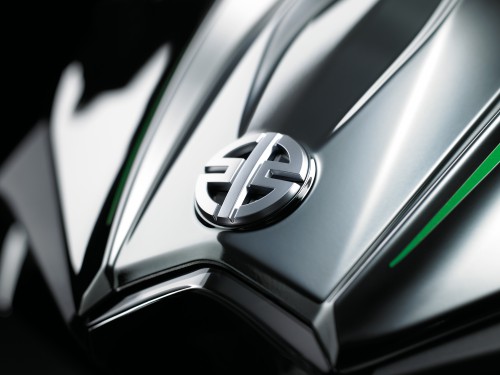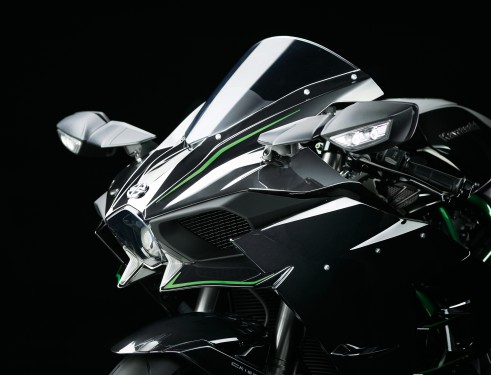Following the huge media interest surrounding the recent unveiling of the stunning Ninja H2R Supercharged track-only motorcycle, Kawasaki has now taken the covers off the street focused Ninja H2 model.
With the vast majority of engine and chassis components common to both machines, the road-ready Ninja H2 is sure to create a huge amount of interest and, already, Kawasaki dealers are reporting incredible customer demand for both forced induction machines.
Using an entirely “in-house” designed and constructed centrifugal type supercharger, the Ninja H2 and Ninja H2R are the result of cooperation between some of the major business areas of Kawasaki Heavy Industries including the Aerospace, Gas Turbine and Corporate Technology divisions. Not bound by design or engineering limitations, the company first show-cased the concept of a supercharger at the Tokyo Motor Show. Now the idea has become reality with the launch of both machines at Milan’s EICMA show featuring many engineering and technology innovations and with a focus very much on a craftsmanship-led look and feel.
With a power figure rated at 200PS for the Ninja H2 and 310PS for the Ninja H2R, each machine is capable of class leading levels of Supersport performance – the Ninja H2 on the street and the Ninja H2R in its closed course only environment. What sets these machines aside from other motorcycles in the litre category is the huge wave of torque it is possible to create by use of a supercharger. Delivering a considerable advantage in terms of phenomenal acceleration across the power range from tick-over to the red line, the supercharger has been tuned to offer the widest spread of available urge at any revs and in any gear while a host of electronic rider aids such as KTRC traction control, advanced KIBS anti-lock brakes and even switchable engine braking functions, create the best possible environment in which to enjoy each supercharged Ninja.
A quick glance at the specification sheets reveals a list of components and design features that underpin the high quality approach to the creation of the Ninja H2 and Ninja H2R. In terms of firsts, there is a formidable list including KYB AOS-II Air-Oil separate inverted 43mm front forks and dog ring transmission – both only previously used on racing machines. Equally, the exquisite and complex single sided swinging arm is a first on any Kawasaki production motorcycle, so too items such as KEBC engine braking control, the KLCM launch control feature, the use of an electronic quick-shifter plus, on a more visual level, the incredible Mirror Coated Black paint on the Ninja H2 the result of an induced chemical reaction that creates a layer of real silver as a base coat. For the track-only Ninja H2R, the wide use of carbon fibre not only saves weight but creates the look and feel of a stealth aircraft.
If you are interested in Kawasaki products, see this premium motorcycle cover.

The quality of design and components does not end there; in fact it is just the start of the process which Kawasaki refers to as “craftsmanship-led”. As series production motorcycles, each Ninja H2 and Ninja H2R are created from start to finish in a dedicated area only for these machines at Kawasaki’s famous Akashi factory in Japan. In an area of the facility set aside for construction, a single person creates each supercharged machine ensuring the highest levels of quality control. Incorporating numerous craftsmanship details such as specially manufactured fixings, new welding techniques for the innovative trellis style chassis and the adoption of top end quality Brembo braking and clutch operating components, both machines in the Ninja H2 stable are destined to be coveted by potential owners and sought after by discerning enthusiasts across the globe.
With limited numbers of Ninja H2 machines available for the 2015 sales season and the Ninja H2R expected in the course of spring 2015, order books are filling fast. The inevitable talk is of both machines being seen in the very near future as Kawasaki icons to be mentioned in the same breath as the 1969 H1 500, the H2 750 Mach IV and Super Four Z1 of 1972 as well as the game-changing GPz900R Ninja of 1984.
One of very few machines in the modern era to carry the historic Kawasaki “river mark”, the Ninja H2 road motorcycle and Ninja H2R track-only machine are set to reinforce Kawasaki’s reputation for building motorcycles that display the very best in performance while delivering an exhilarating experience, coupled with outstanding engineering and technology innovations.
via Kawasaki
Related items:


